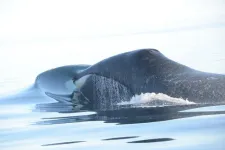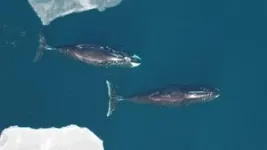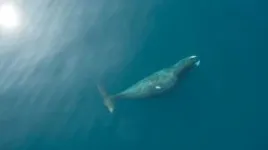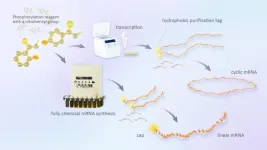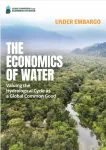(Press-News.org) A new study has raised questions about current approaches to predicting the risk of vessel strikes on whales.
Led by researchers at Heriot-Watt University in Edinburgh, Scotland, an international team of scientists compared eight models currently in place to assess and forecast the risk of ships colliding with whales. The study reveals notable inconsistencies in the results across the different models.
Most reports of vessel collisions involve large whales but all species can be affected. Globally, strikes are under-reported and can often go undetected, particularly when they involve large vessels. Collisions can result in animals being injured or killed, and vessels may also sustain substantial damage.
Approaches for identifying areas of high collision risk have been used by marine managers and policy makers for more than 20 years to try to understand where vessels are more likely to encounter large marine life and explore where it might be most effective to deploy management measures to reduce the risk of fatal collisions.
Once an area is identified as being of high collision risk, steps such as slowing down vessels and moving them away from areas where there is a high likelihood of them encountering whales are just some of the ways that have been shown to be effective at reducing incidents.
For the first time, this study has considered how using different approaches for evaluating strike risk has consequences for areas identified as high risk. The significance of these findings could hold global implications for the management of vessel traffic.
Emily Hague is the lead author and a researcher from the Institute of Life and Earth Sciences at Heriot-Watt University.
She said: “In this paper, we looked at the different methods that exist to map collision risk and found that they came up with similar, but fundamentally different, predictions. Some approaches identified the same places as being ‘high risk’, whereas other models identified quite different locations or sizes of areas.
“These methods have previously been seen as interchangeable, which we show is not necessarily the case.”
She continues: “We hope to improve transparency surrounding whale-collision risk mapping, so managers and policymakers know the limitations and strengths of each approach and can consider the best approach and type of data they need for their particular area and requirements.”
“We hope this work can contribute to the body of work that is working towards reducing ship strike to whales, and ultimately aiding their conservation.”
The paper compares existing methods for predicting vessel strikes including the most-up-to-date techniques.
The team used the same datasets to compare the outputs of each of the different approaches. These included data on the distribution of the whales in the study area and data on the vessels that were present over a comparable period.
Dr Lauren McWhinnie who is an Assistant Professor at Heriot-Watt University and the project lead, explains why there is a need for accurate modelling.
“The reality is we’ve got lucky and now have a second chance with these animals after commercial hunting pushed many species to the brink of extinction,” she said.
“Fortunately, there are many species now showing signs of recovery but our maritime sector has largely evolved without the presence of large whales in any great numbers. This has meant that we are only now starting to understand how these animals might be impacted by human activities such as shipping”
“In the future, if we want to try and ensure the further recovery of these species, then we need to put in place measures to mitigate against modern-day risks that pose a threat to whale survival. We know that for some populations of whales, vessel strikes are one of the primary threats to their recovery, so we need to be proactive and take the steps needed to protect them.”
The authors highlight the importance of careful consideration when deciding upon which approaches are most appropriate to use for predicting vessel collision risk. These choices, the paper explains, have substantial implications on the areas identified by risk maps and could have subsequent implications for management or policy decisions arising from the results.
Emily concludes: “It's important that we use the best available data and models so that we can better inform shipping companies how they can minimise the likelihood of colliding with whales.”
Vessel strikes are one of the greatest threats to a whale’s life. With the number of ships rapidly increasing to keep pace with global demand for goods, the issue is only set to get worse. However, there is a growing political willingness to take action to protect the oceans and its habitats, with the UN Ocean Decade underway, and the International Maritime Organisation (IMO) increasingly working with the shipping industry to ensure heavily trafficked areas do not affect large whales.
The paper, titled: ‘Not all maps are equal: Evaluating approaches for mapping vessel collision risk to large baleen whales’, has been published today (Oct 17) in the Journal of Applied Ecology and is part of a wider four-year project being funded by the European Union Horizon 2020 Research and Innovation Programme.
It involved contributions from international researchers, scientists and organisations including the Wildlife Conservation Society in Canada, the School of Earth and Ocean Sciences at the University of Victoria, the Department of Geography, Environment, and Geomatics at the University of Ottawa, Fisheries and Oceans Canada, the Greenland Institute of Natural Resources, Transport Canada, the School of Biological Sciences and School of Geosciences at the University of Aberdeen, the National Decommissioning Centre, and the Department of Geography at the University of Victoria.
END
Marine experts challenge reliability of vessel strike prediction models
2024-10-17
ELSE PRESS RELEASES FROM THIS DATE:
USC study finds link between PFAS, kidney function and gut health
2024-10-17
New research has revealed that the connection between per- and polyfluoroalkyl substances, or PFAS, and kidney damage may be tied to dysregulation of the gut microbiome, which is made up of bacteria and other microorganisms that live in the digestive tract.
PFAS are manufactured chemicals used in a wide range of products, including everything from furniture to food packaging. They are often called “forever chemicals” because once they accumulate in the environment or the human body, they take a very long ...
Compound drought-heatwave events underrecognized in global soils
2024-10-17
Soil is essential for life and plays a crucial role in Earth's ecosystem, providing support for plant roots and hosting countless microorganisms. In a warming world, it is important to understand how soil hydrothermal conditions, particularly dry-hot extremes, have changed already and how they will respond to further warming.
In a study published in PNAS, researchers led by Prof. ZHANG Yunlin from the Nanjing Institute of Geography and Limnology of the Chinese Academy of Sciences, along with collaborators from the Helmholtz Centre for Environmental Research (UFZ) and Bangor University, have quantified global soil compound drought-heatwave (SCDHW) ...
Pursuing the biological mechanisms and diversity of marine life through international collaboration
2024-10-17
The Okinawa Institute of Science and Technology (OIST) and France’s National Centre for Scientific Research (CNRS) have signed an agreement to establish the International Research Laboratory “Eco-Evo-Devo of Coral Reef Fish Life Cycle” (IRL EARLY). The ceremony took place on October 7 at the STS Forum in Kyoto, Japan.
Since life began in our oceans, it has diversified into a wide variety of different organisms. However, the true extent of marine diversity remains unknown, as do many species and their ecologies. Investigating the biological mechanisms of marine life can not only provide a deeper understanding of the life cycles and evolution of these organisms, it ...
Europe’s First ever conference for minoritised life scientists set for Spring 2025
2024-10-17
A unique group of life science professionals and advocates has come together to launch the Minoritised Life Scientists Future Forum, the first major conference in Europe dedicated to supporting and showcasing the contributions of marginalised and underrepresented communities in the life sciences.
Taking place at the ICC Birmingham from 31 March to 2 April 2025, the Future Forum will offer over 200 hours of inspiring talks, workshops, and mentoring sessions. The event is designed for life scientists at all career stages from undergraduate students to early-career ...
mRNA vaccines for disease outbreaks can be synthesized in less time with new technique
2024-10-17
In an era where viral outbreaks can escalate into global pandemics with alarming speed, the ability to quickly develop new vaccines has become crucial. However, the speed of vaccine production is limited because the mRNA used in it is partly chemically synthesized and partly synthesized using enzymes, a relatively slow process.
A team of researchers from Nagoya University in Japan has successfully developed an innovative synthesis technology capable of producing high purity, fully chemically ...
UK health leaders urge chancellor to invest in a smoke-free UK
2024-10-16
Over 200 leading doctors, professional bodies and charities are urging the chancellor to use the budget on 30 October to invest in creating a smoke free UK as quickly as possible, and make the tobacco industry pay.
In an open letter published by The BMJ today, they warn that unless smoking is addressed, there is no prospect of delivering on Labour’s manifesto commitment to halve the gap in healthy life expectancy between the richest and poorest regions.
The rationale for investing to end the tobacco epidemic could not be stronger, they explain. The annual cost of smoking to individuals, public ...
No link to birth defects for potential fathers taking metformin for diabetes
2024-10-16
Potential fathers with type 2 diabetes can be reassured that taking the drug metformin is not associated with birth defects in their offspring, concludes a large study of more than 3 million pregnancies published by The BMJ today.
The researchers say the findings show that metformin can continue to be considered a suitable drug for managing blood sugar levels in men with type 2 diabetes who plan on having children.
Metformin is widely used to treat type 2 diabetes in men of reproductive age, but a recent Danish study reported a link between metformin use by fathers-to-be and an increased ...
For multiple sclerosis, medication and cognitive behavioral therapy can reduce fatigue
2024-10-16
In a study of commonly used treatments for people with multiple sclerosis, both medical and behavioral interventions, and a combination of the two, resulted in meaningful improvements in fatigue, a University of Michigan-led study finds.
The randomized clinical trial compared the effectiveness of modafinil, a wake-promoting medication used to treat sleepiness in people with sleep disorders, and cognitive behavioral therapy, or CBT, on reducing fatigue for over 300 adults with multiple sclerosis whose symptoms interfered with their ...
Children with multiple long-term conditions hospitalized with COVID are almost three times more likely to die: New study
2024-10-16
Individuals with multiple long-term conditions are two and a half times more likely to die following COVID-19 infection than others. When children were assessed separately the risk for mortality among those with multiple long-term conditions increased to almost three times (2.8) the risk of those without. The mortality rates are 22% and 8% respectively.
That is according to an authoritative systematic review and meta-analysis of over four million patients with COVID-19 published today (Thursday 17 October) in the Journal of the Royal Society of Medicine.
The authors are calling for patients with multiple long-term conditions ...
8% GDP loss by 2050 foreseen due to world water crisis; more than 50% of food production at risk: Global Commission on the Economics of Water
2024-10-16
Paris — An international group of leaders and experts warns that unless humanity acts with greater boldness and urgency, an increasingly out-of-balance water cycle will wreak havoc on economies and humanity worldwide.
In a landmark report, The Economics of Water: Valuing the Hydrological Cycle as a Global Common Good, the Global Commission on the Economics of Water says the water crisis puts at risk more than half of the world’s food production by 2050. It also threatens an 8% loss of GDP in countries around the world on average by 2050, with as much ...
